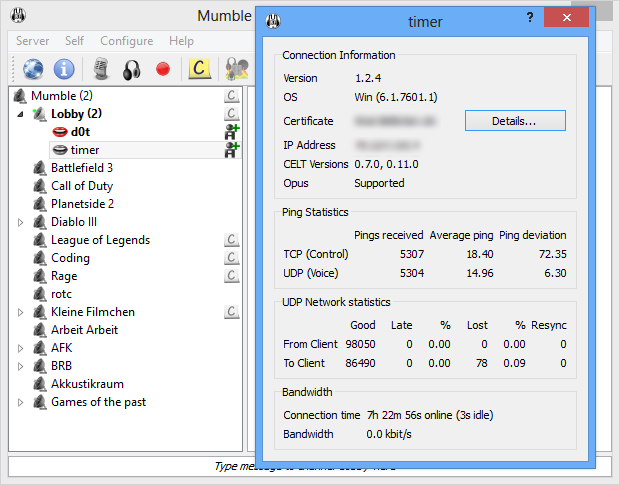 Versie 1.5.634 van Mumble is uitgekomen, de eerste stabiele uitgave uit 1.5-serie. Mumble is een opensource- en crossplatform-voip-programma. Clients zijn beschikbaar voor Windows, Linux, macOS, Android en iOS. De communicatie vindt altijd over een versleutelde verbinding plaats en kent een lage latency. Wordt het binnen spellen gebruikt, dan kan aan de hand van een overlay worden getoond wie er spreekt en bovendien is het programma in staat om de positie van die ander te herkennen en het geluid zo weer te geven dat je kunt horen waar die speler zich bevindt. De releasenotes voor deze uitgave kunnen hieronder worden gevonden.
Versie 1.5.634 van Mumble is uitgekomen, de eerste stabiele uitgave uit 1.5-serie. Mumble is een opensource- en crossplatform-voip-programma. Clients zijn beschikbaar voor Windows, Linux, macOS, Android en iOS. De communicatie vindt altijd over een versleutelde verbinding plaats en kent een lage latency. Wordt het binnen spellen gebruikt, dan kan aan de hand van een overlay worden getoond wie er spreekt en bovendien is het programma in staat om de positie van die ander te herkennen en het geluid zo weer te geven dat je kunt horen waar die speler zich bevindt. De releasenotes voor deze uitgave kunnen hieronder worden gevonden.
Mumble 1.5.634
Almost two years after the previous stable release Mumble 1.4.287, a lot of changes have been made to the codebase. With this update, you will surely notice some long-standing bugs fixed, as well as some convenient changes that were long overdue. In the time between the major versions, the project has exceeded the 10,000 commit mark and now has over 350 contributors. Thanks to all of you who contributed, translated, submitted issues, and tested pre-releases! Without you, the Mumble project would not be possible at this scale.
While the changelog is quite long, the amount of notable client changes is relatively small. For this release, we focus on the few main changes. For the interested reader, we of course also include a full changelog at the bottom of this page as well. If you are wondering why this first 1.5.x release is not version 1.5.0, but 1.5.634, please see this old blog post describing our new versioning scheme that explains the absence of the aforementioned version numbers.
Feature spotlight
Positional audio improvementsThere have been some changes to the positional audio system, especially to better fine-tune the configuration. The maximum distance thresholds have been significantly increased. The option to set a minimum volume of 0 has been brought back. And some clever psychoacoustic effects, such as interaural delay as well as improved blooming will enhance the positional audio experience even more.
For those users who wish to develop positional audio plugins - or try to debug them - we have added a convenient “Positional Audio Viewer” to the developer context menu. This replaces the existing external “MumblePAHelper” with an in-client solution. It shows you the positional information of your client and the associated metadata in real-time. For the positional audio viewer in action see: https://odysee.com/@Mumble:5/positional-audio-viewer-left4dead:f
UI and accessibility overhaulMumble 1.5 introduces some quality-of-life UI changes alongside the long-awaited accessibility overhaul. In the software context, accessibility features (often abbreviated as “a11y”) are considerations and tools meant to reduce the hassle of running a specific application for users with disabilities. Most often, you will find features specifically crafted or tweaked for visually impaired users, but other disabilities such as cognitive or motor impairments should also be considered.
We ensured that the entire application is now keyboard navigable and removed any existing focus traps. We also implemented forwarding of some context information, such as the muted/deafened state of other users, are now forwarded to screen readers. Also, all existing settings pages, their contents, and any actions that were previously only available as a toolbar button are now usable without a mouse. If you are using a screen reader or other accessibility tooling and have any trouble using Mumble 1.5.634, make sure to let us know via our GitHub issue tracker. We want to make sure the application is usable by everyone.
For users regulary connecting to very large Mumble servers, some neat features were added to make life easier: The new message thresholding options will make Mumble suppress certain notifications when a configurable user limit is reached on the server. Additionally, users are now able to not only hide certain channels explicitly when activating the channel filter, but also pin channels in the filtered view even when they are empty. The new inline local volume adjustment slider removes the complexity of using a dedicated popup menu and therefore reduces the required clicks for the same action significantly.
A lot of new global shortcut actions were added, including many of the menubar options, allowing to control Mumble with ease even when the window is minimized or a fullscreen application is running. Furthermore, the volume of notifications, audio cues, and text-to-speech can now be changed separately. There have also been quite a lot of UI fixes, such as the chat log scrolling up when a new image is posted, the “channel name links” not behaving correctly in the chat log, hiding UI elements not being persistent, and more!
Persistent channel listenersChannel Listeners - a feature introduced in Mumble 1.4 - were previously only valid for the current user session. In this release, we introduce persistent channel listeners for registered users. That means existing listeners and their respective volume adjustments will be remembered by the server across reconnections.


:strip_exif()/i/1370182566.png?f=thumbmedium)